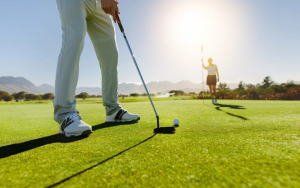If you’re just getting into golf, it can feel a bit overwhelming trying to figure out all the equipment you need. As someone who picked up the game later in life, I’ve been there! While golf certainly requires some investment, you don’t need to break the bank to get started. Here’s my advice on the must-have gear and tips for golfing beginners.
The Essential Golf Clubs
As a beginner, you can get by with just a few clubs to start:
- Driver: This is the club you’ll use for your longest shots off the tee. Drivers have large club heads and are designed to maximize distance. Go for a name brand like Callaway or TaylorMade. Expect to pay $200-400 for a decent starter model.
- Irons: You’ll want a starter iron set of 5-9 irons. These are used for shorter approach shots into the green. A boxed beginner set from a major brand will run you $300-500.
- Wedge: Wedges are essential for tricky in-between shots where you need loft and spin. A pitching wedge and sand wedge cover most needs for beginners. $50-150 each.
- Putter: Arguably the most important club. You’ll use it on every hole. Get one that feels comfortable and suits your stroke. Costs range from $50 for a basic putter to $300+ for high-end models.
- Hybrid: This versatile “rescue” club combines qualities of irons and woods. It can really help beginners on tricky shots. Add a hybrid in the $100-200 range if you can.
Other Golf Equipment Essentials
In addition to clubs, you’ll need these basics:
- Golf balls: Buy a bulk pack of basic 2-piece balls meant for beginners. You’ll lose a lot of balls starting out!
- Golf shoes: Get shoes with soft spikes or spikeless shoes with good traction. $50-150.
- Golf glove: Wearing a glove improves grip and saves your skin from blisters. $10-25.
- Golf bag: Carry bags are lightweight and ideal for beginners. Invest in a stand bag with legs as you progress. $100-300.
- Golf clothes: Collared polo shirts and casual pants or shorts are typical golf attire.
- Club brush: Keep clubs groove-free of grass and dirt. $5-10.
- Ball mark repair tool: Fix ball marks on the putting green. $5.
- Divot tool: Repair divots you take on fairways. $5-10.
- Tees: Basic plastic tees to start. You’ll need lots! 5 packs for $10-20.
- Ball mark: Mark your golf ball with a permanent pen for identification. $5.
- Sunscreen & hat: Protect yourself from the elements!
- Golf towels: Useful for cleaning equipment and hands. $10-20.
- Rangefinder (optional): Handy gadget for measuring yardage. $100+.
Where to Buy Your Golf Equipment
Quality starter sets are available at reasonable prices from retailers like Dick’s Sporting Goods, Golf Galaxy, and Edwin Watts. Also check local marketplaces near you to buy Golf equipment, although I am a regular buyer of Discount Golf Store, it is because of Discount Golf Store vouchers, as when I use them I get affordable prices. Also local shops and golf courses may also have good deals for beginners.
Shop end-of-season sales in fall and winter to save money. But make sure to get properly fitted clubs – don’t just buy a starter set blindly online. Getting the right club lengths and flexes suits your swing is very important when starting out.
Taking Lessons as a Beginner
As a new golfer, taking some lessons early on can ingrain good fundamentals and help you improve much faster. PGA professionals can analyze your swing and offer tailored advice. Don’t try to teach yourself entirely from YouTube!
Most golf courses offer individual and group lesson options. Look for a well-reviewed local pro who has experience teaching beginners. Expect to pay $50-100+ per hour-long private lesson. Group clinics are more affordable at $20-40 per session.
Even just a few lessons early on can be invaluable to start off on the right foot and avoid developing bad habits. Consider recording your swing and asking the instructor for feedback. Don’t overload yourself with too much swing theory early on though. Work gradually on building a repeating swing.
Getting in Practice Time
Once you have clubs and some basic instruction, it’s time to practice, practice, practice! Here are great ways to get experience as a new golfer:
- Take advantage of driving ranges – buy big buckets of balls and work through your clubs. Focus on consistent ball-striking.
- Play pitch and putt courses to improve your short game skills.
- Book twilight tee times to play easy beginner-friendly courses. Don’t get discouraged by bad shots!
- Play executive or par-3 courses to get course experience without as much pressure.
- See if any local courses offer free beginner golf clinics or get started lessons.
- Swing gently and smoothly – don’t try to crush the ball when starting out. Developing consistency is key.
- Keep a pocket notebook to track your shots, strokes, and areas needing improvement.
Learning Golf Rules and Etiquette
As a newcomer, you’ll need to quickly learn basic golf rules and etiquette like:
- Honor the dress code if required at courses. Be respectful.
- Let faster groups play through if you fall behind pace.
- Don’t talk loudly or play music on the course. Maintain a calm demeanor.
- Avoid excessive practice swings – no more than 3 typically.
- Rake bunkers smoothly after hitting and fix divots in fairways.
- Keep carts away from greens and tees. Follow cart rules.
- Don’t walk through anyone’s putting line on the green.
- Shake hands and compliment playing partners after finishing a hole.
- Limit yourself to no more than double par on any hole to keep pace.
- Familiarize yourself with gimmes, provisionals, water hazards, OB, and other rules.
The golf community is very welcoming of newcomers who demonstrate etiquette and care for the course. Don’t be afraid to ask for advice!
FAQs for Beginner Golfers
Q: What are 5 golf clubs I should start with as a beginner?
A: Driver, 6-7 iron, pitching wedge, sand wedge, and putter. Add a mid iron like an 8 iron and hybrid later.
Q: What accessories do I need when first learning golf?
A: At minimum get golf balls, tees, ball mark repair tool, divot tool, glove, shoes, and sun protection.
Q: Should I get cheap used clubs to start?
A: Be cautious of very old hand-me-down clubs. Better to get a boxed starter set from a major brand fitted to your size.
Q: How often should a beginner take lessons?
A: Try to take 4-6 lessons spaced out over your first couple months learning. Then go back for periodic tune-up lessons as you improve. Don’t overload yourself.
Q: What’s the best way to learn golf rules?
A: Read the basic rules overview on USGA.org. Play with experienced golfers who can teach you. Learn by experience playing courses.
As per suggestion by Repelis24 Sports write for us starting out in golf can be daunting but very rewarding. Stick with it through early frustrations and you’ll quickly improve. Let the game’s traditions and challenges draw you in. With the right attitude and practice, you’ll be shooting par in no time! Enjoy the walk and have fun! Golf is a game for a lifetime.





